Best Practices to Ensure Sourcing and Outsourcing Are Strategic Levers for Competitive Advantage
Optimally designed SSO program can allow companies to deliver therapies to patients faster and at a more affordable cost.

Pharmaceutical leaders are at the center of extraordinary changes, with COVID-19 forcing them to re-evaluate their strategic roadmap and plans to remain competitive within the rapidly transforming industry. Expectations from patients, regulators, and the general public have increased significantly, due to the rapid development of the COVID vaccines. There is now a broader belief within the industry that it can be more agile than before in developing and delivering much-needed medicines safer and faster.
As industry leaders prepare their organizations for improved competitive positioning in the post-pandemic era, they are faced with several old and new challenges:1
- Rapidly changing consumer/patient expectations—a patient-centricity theme
- Cyberthreats—increased adoption of technological advances across the pharmaceutical value chain
- Continued inefficiency of the R&D process2
- Clinical trials stopped or delayed due to COVID
- A move toward a hybrid, remote, and distributed operating environment, and associated recruiting, retention, training, and staffing policy changes
- Evolving digital transformation approaches leveraging artificial intelligence (AI), machine learning (ML), the Internet of Things (IoT), and wearables/mobile devices
- The adoption of new operating models (e.g., decentralized clinical trials or DCT) that require fundamental changes to organizational structure, processes, and the extension of partnership models
- Pressure from government, regulatory, public policy, and patients to reduce the cost of medicines/treatment modalities.
Targeted and coordinated efforts to overcome these challenges can provide significant opportunities and allow the industry to transition to the next decade of growth. Leaders within the industry have started to channel their focus on some strategic priorities to convert these opportunities into competitive benefits as described below:
Many large pharma companies are trying to utilize the momentum in R&D across oncology, gene therapy, cell therapy or gene-modified gene therapy, DNA/RNA therapeutics, and monoclonal/conjugated monoclonal antibodies.2 Toward generating capital for these investments, industry has seen an increase in spinoffs (in addition to M&A) of units that are growing slower or have become less strategic for the company’s future growth plans.3 Some examples are Merck’s plan to spin off its women’s health, biosimilars, and legacy products business, and Novartis’ strategy to split from Alcon and consideration of separation from its consumer unit, Sandoz.
Rapidly evolving digital technologies across AI/ML and natural language processing (NLP) and cloud-based platforms are allowing fundamental transformation of core functions within pharma (e.g., digital clinical and digital commercial). These advancements are providing data visibility and predictive analytics/insights for real-time decision-making for improved operational performance and customer satisfaction (e.g., virtual/decentralized clinical trials that allow more effective end-to-end patient management for improved patient recruitment, retention, and overall satisfaction).
New and evolving collaborative models that are rapidly growing between pharmaceutical companies, regulators, patients, and providers such as the recent ones that allowed the industry to develop and deliver the COVID vaccines within unprecedented timelines.4 Collaborations between pharma and big technology companies can also be a source of growth and innovation for pharma. A recent example is the collaboration to leverage quantum computing to accelerate R&D between Boehringer Ingelheim and Google.5
Being at an influx point and undergoing broad-based transformation, it seems timely for the industry to leverage some of the key observations from Michael Porter’s landmark paper on competitive advantage6 and Jay Barney’s Firm Resources and Sustained Competitive Advantage.7 The relevance of these observations to the industry’s current priorities and efforts can be summarized along three key factors:
- Cost—Industry is expanding its efforts on reducing total cost of operations through improved R&D models, collaboration, automation, and digital technologies (e.g., DCT). With increasing demand for highly specialized and diversified resources, they are optimizing their resourcing models and labor pool through a combination of internal and broader sourcing and outsourcing partnerships.
- Differentiation and focus—Toward maintaining their competitive positioning, industry leaders are pursuing multiple strategies to differentiate in the marketplace. Some of these levers include increased investments in their core therapeutic areas and portfolio of products that are safer and have higher efficacy vs. existing products, targeted development of treatments for rare diseases, and ensuring improved customer delivery and value through patient centricity, end-to-end patient management, and outcomes.
- Resource-based view (RBV) and VRIN (Valuable, Rare, Inimitable, and Non-substitutable)5—Barney’s framework details how the combination of specialized skills and resources make a company unique and can provide a competitive advantage. This is a highly relevant and critical topic for pharmaceutical companies at the present time as they increase their efforts to recruit, train/re-train, and retain staff with the most diverse set of skills and capabilities. Research shows that about 70% of organizations report finding and attracting quality staff as one of their top challenges.8 They need to follow a multi-pronged approach to ensure success in their efforts, which will in turn improve their competitive position in the industry. One of these approaches could be the effective leverage of their outsourcing partnership and the depth and expertise of the skills that they can provide.
Systematic approach to leveraging SSO for sustainable competitive advantage
Companies have outsourced business process management/services and technology primarily as a cost-saving strategy over the past decade.9 But industries have realized that ownership of all capabilities alone is not critical; the ability to control and leverage the most use of its critical capabilities, whether they own the capability or are owned by their partners, is equally important.10
Increasingly, organizations have been leveraging their partners for operational improvements, such as automation and migration to cloud. The trend is further shifting as they plan to accelerate transformation projects and anticipate relying on service providers more heavily in the future. This approach is complementary to their strategy of building their internal capabilities across people, process, and technology for driving strategic innovation and transformation programs.
Sourcing and outsourcing can provide significant contributions to a pharmaceutical company’s competitive growth objectives, provided they are considered strategic and designed, and implemented from this perspective.
Based on some of the best practices from our own experiences in the design and implementation of SSO programs for many life sciences clients, we have outlined a stepwise approach and key activities to realize the sustained benefits of SSO:
- Secure executive commitment to sourcing and outsourcing as a strategic lever: Ensure buy-in from business, technology, and other enabling functions—not just from procurement and sourcing teams. This should include the clear definition and communication of the company’s SSO goals and specific objectives in a step-by-step manner and anticipated benefits from these initiatives for the organization and for the staff. Aligning the organization’s change and communication management efforts to the SSO plans, timelines, and stakeholders is also a critical requirement for the success of the programs.
- Develop SSO guiding objectives: Integrate industry best practices/trends and the company’s business strategy drivers into a set of defined global SSO guiding objectives that can be used to further develop the SSO process, methodologies, metrics, roles, and responsibilities11,12 (see Figure 1 below).

- Align global strategic sourcing objectives with business strategic objectives: To ensure successful implementation and adherence, the objectives should be specific and measurable. A balanced scorecard (BSC) illustration is shown in Figure 2 below. The objectives indicated in the BSC include some of the industry trends and will vary based on the individual organization, its strategic and competitive imperatives, and its maturity in the strategic outsourcing space. The weightage allocation to the four levers will also change based on the organization and the industry (see Figure 3 below).
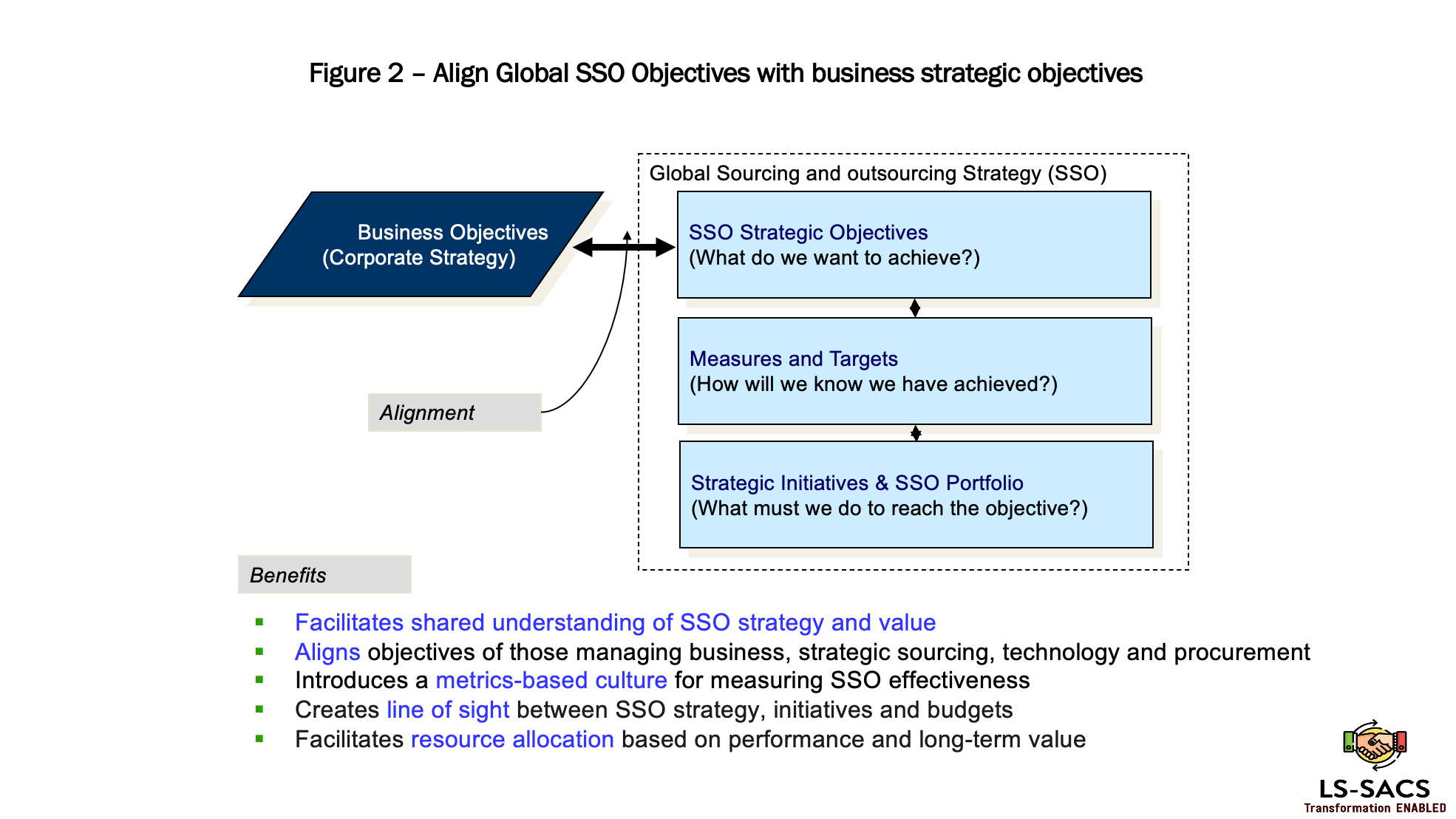
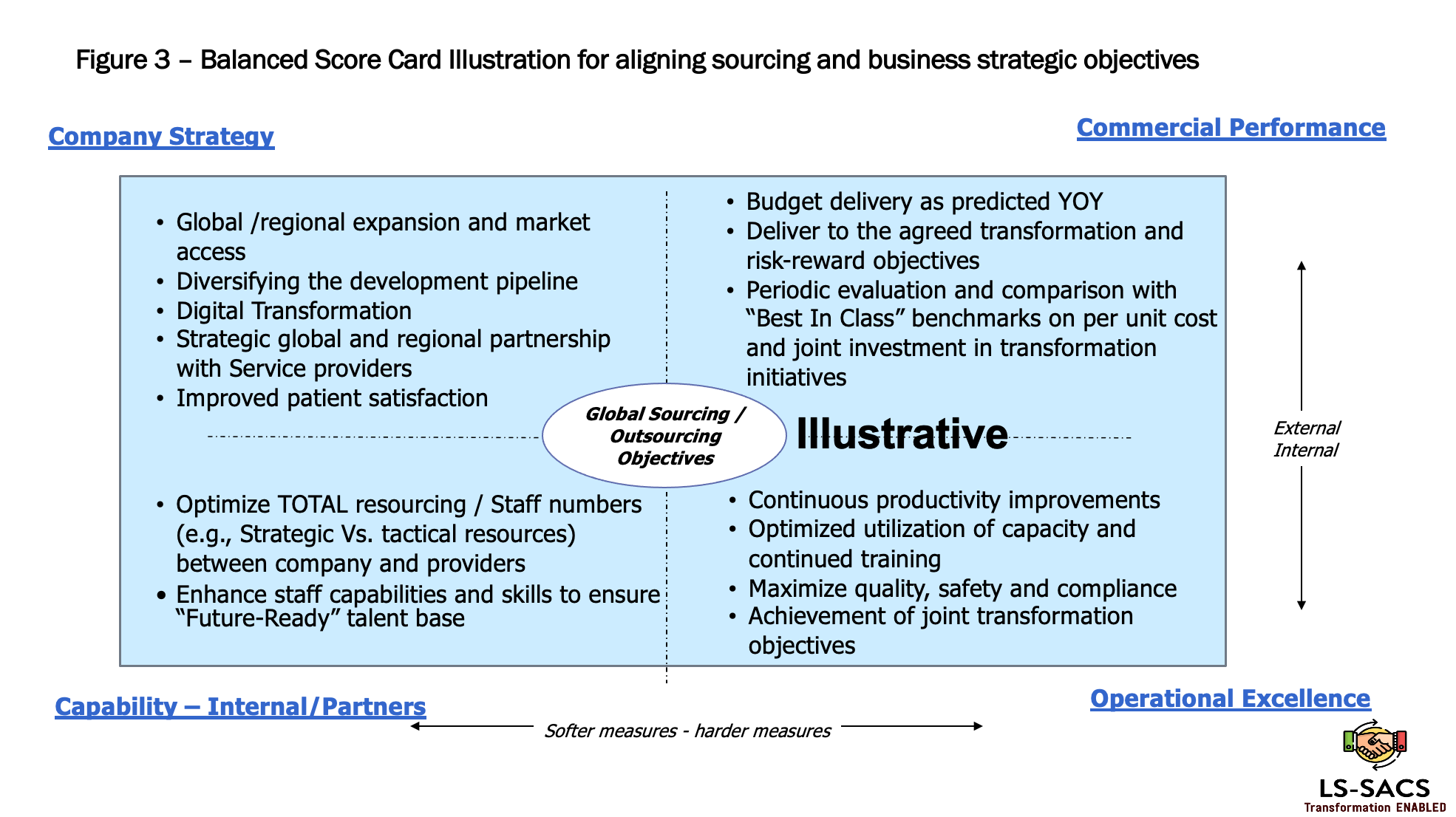
- Translate SSO objectives into a global sourcing and outsourcing portfolio: Use systematic analyses and evaluate core and non-core processes, activities, and technologies, and answer critical sourcing portfolio questions such as “what and why, where and to whom, when and how?” While several of the functions and processes have been traditionally outsourced for a few decades, the success of these initiatives has allowed the industry to consider additional areas for outsourcing (evolving areas). The outsourceability of these functions and activities has to be evaluated and validated in tune with benchmarks and risks/rewards. Functions and activities that typically should be retained internally are identified as core competencies, while this is also being continually redefined by leaders in the industry (see Figure 4 below). An illustration of a typical outsourceability portfolio analysis (OPA) approach is provided in Figure 5 below.
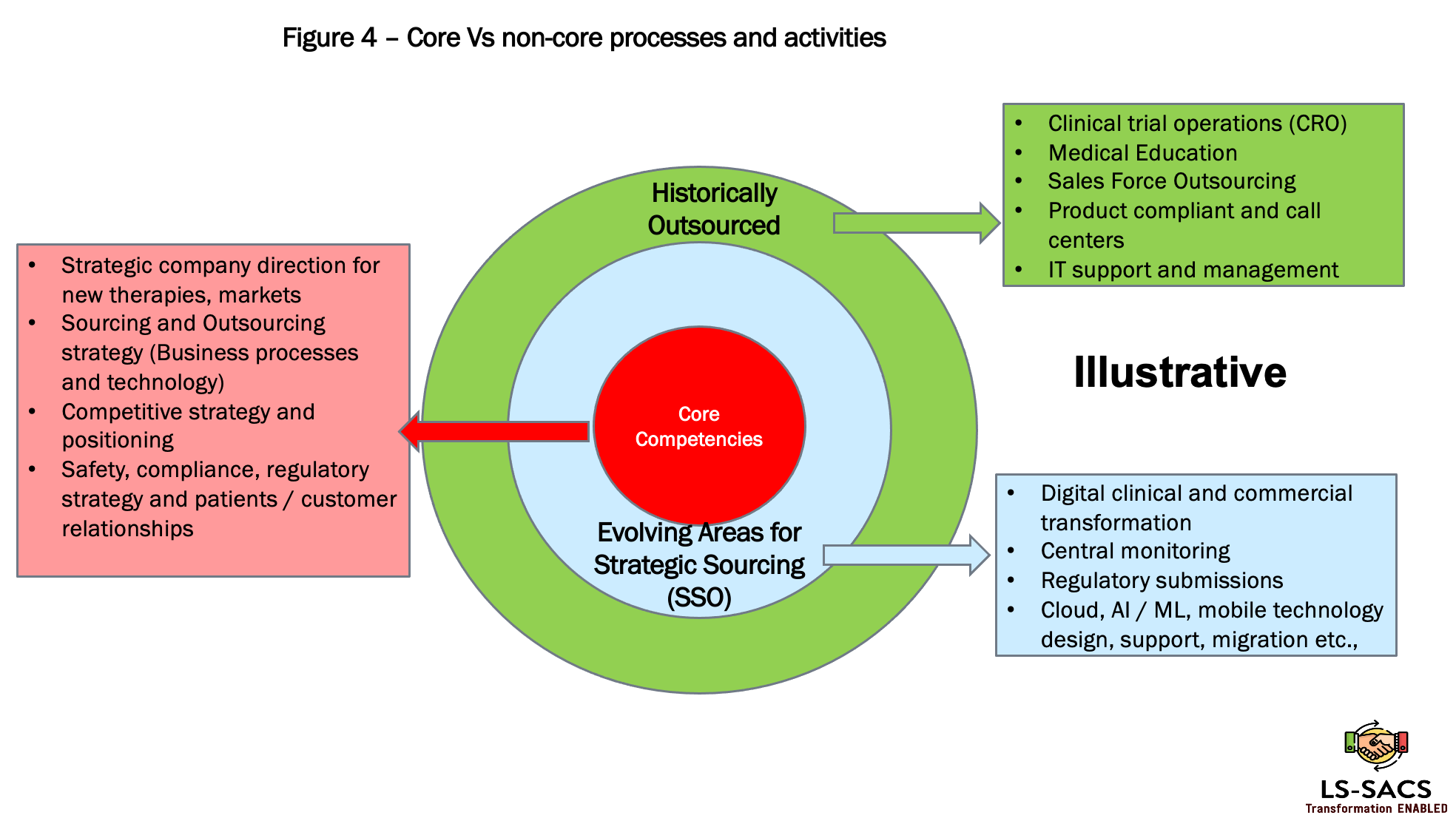

- Optimize and develop a comprehensive global end-to-end sourcing process: SSO should incorporate new ways of working globally in a hybrid model, types of engagement models, and a flexible set of partnerships that are strategic in nature. The contracts with service providers need to be future-ready with shared outcomes that are aligned not only with cost-savings goals but with the organization’s transformation objectives.11,12
- Design and implement an empowered service management group (SMG): SMG manages the portfolio of sourcing initiatives, partnerships, and outcomes effectively in collaboration with procurement and other functions. SMG will ensure optimal governance, transition, transformation, process adherence, SOP, and regulatory compliance, and ensure that the SSO benefits are realized in a sustainable manner. The structure, size, and roles/responsibilities of the SMG can be optimized to align with the organization’s strategy, vision, size, and scale of the SSO programs being planned (see Figure 6 below).
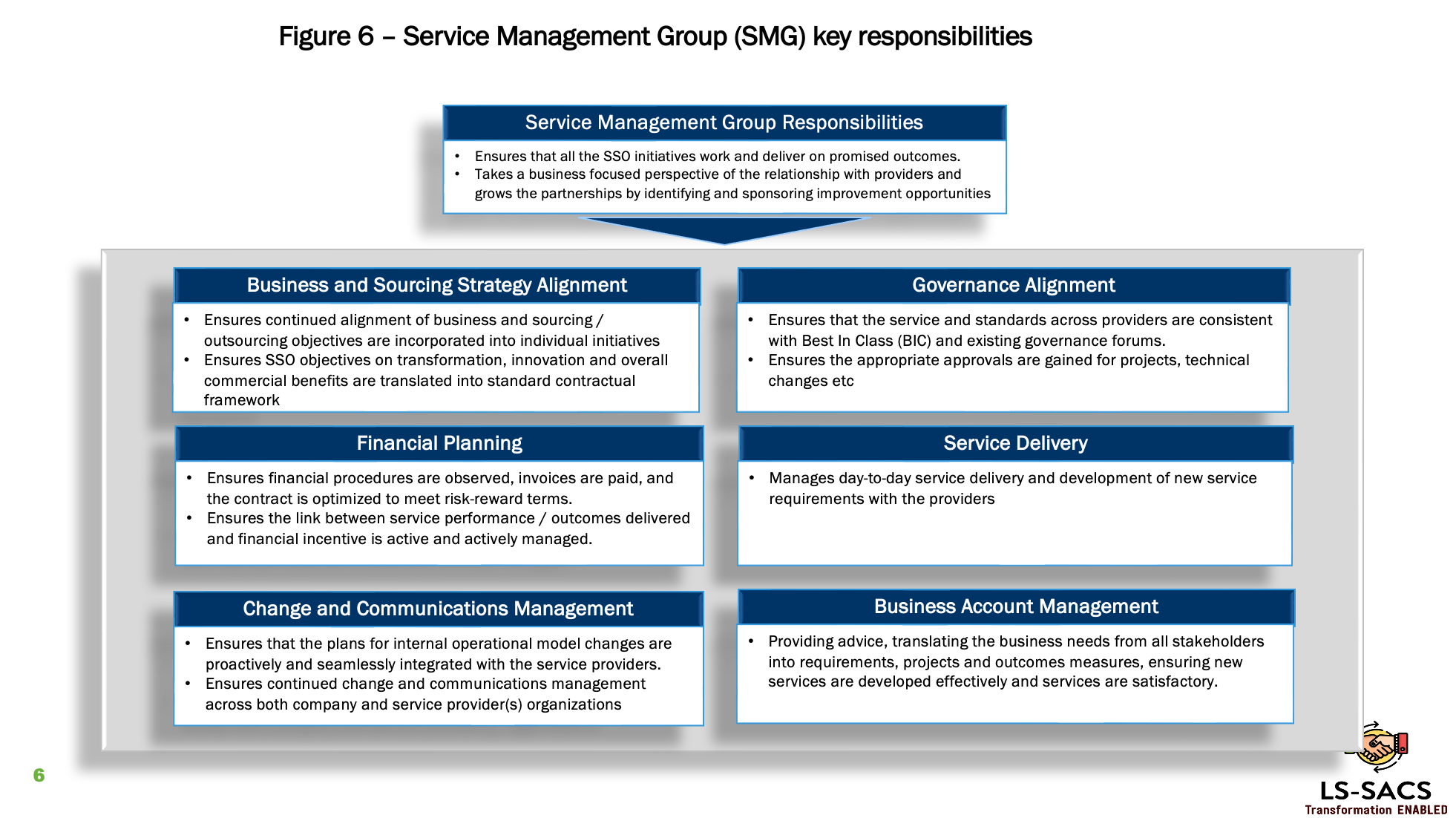
- Governance: A key aspect of SSO that sometimes gets less attention is the design and implementation of a robust joint governance structure with active participation from senior leadership and operational leaders from both the pharmaceutical company and the provider organizations. We have seen that the presence of structed joint governance forums, planned deliverables, and roles and responsibilities lead to sustained benefits from the SSO programs and the transformation initiatives (see Figure 7 below).
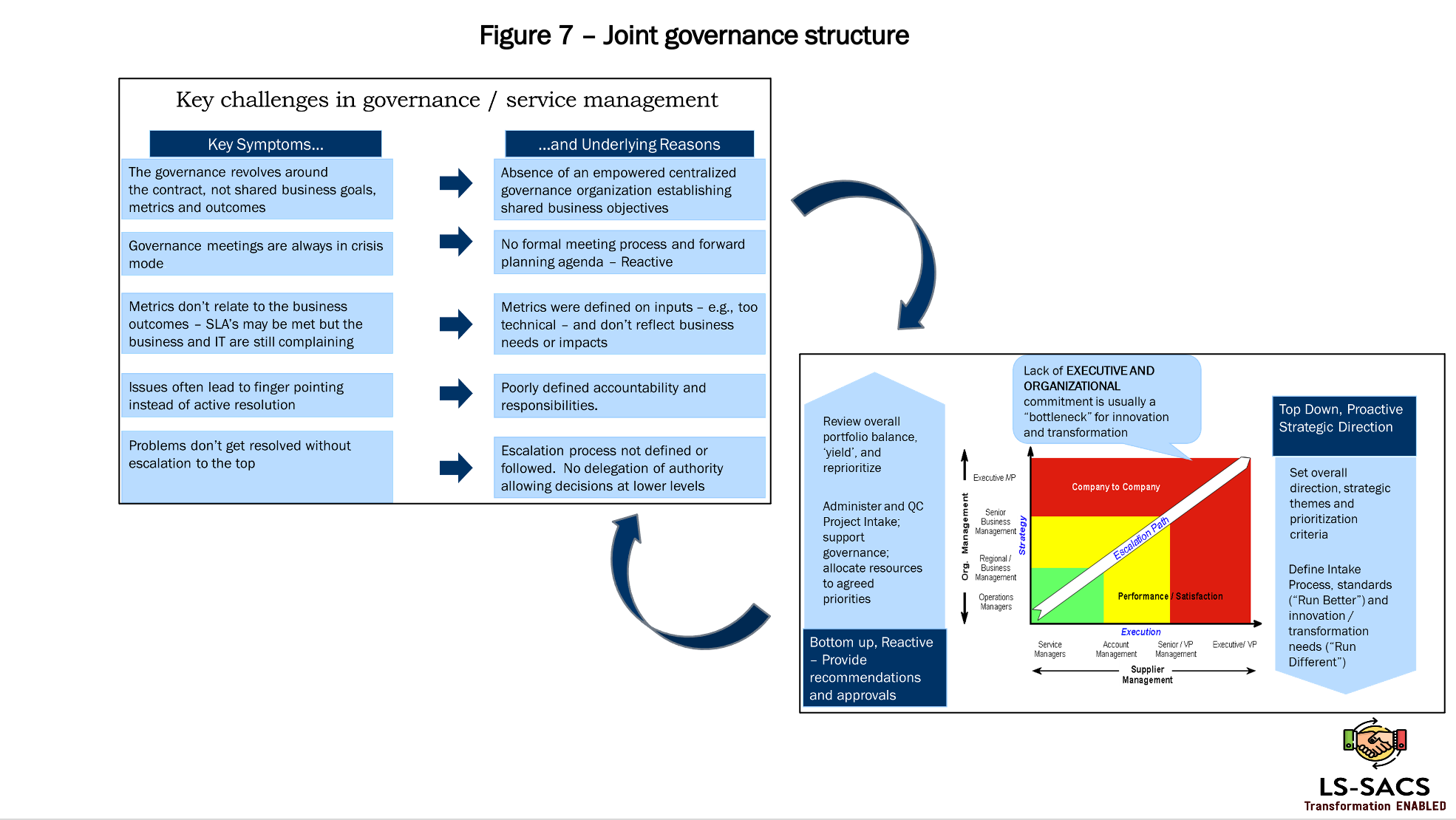
Finally, in a true SSO scenario, both the organization and its providers can incorporate some of their key partnership objectives into the performance goals of their core program teams to ensure that SSO programs and partnerships deliver sustained competitive advantages and benefits to both organizations (see Figure 8 below).
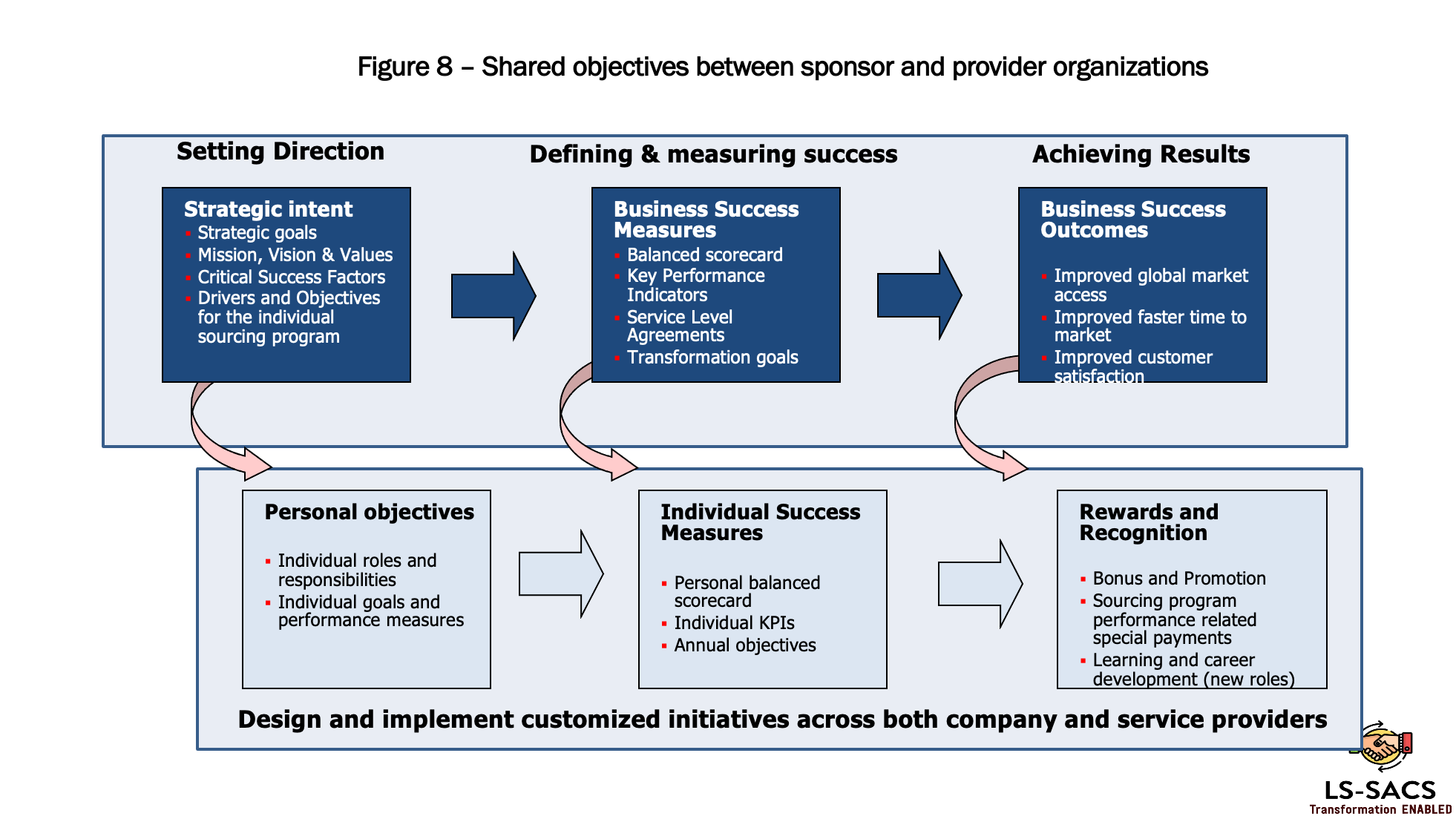
In conclusion, we are in an exciting stage of transformation across the pharmaceutical value chain, with tangible options for leaders to improve their competitive positioning and to deliver on many of their stated strategic objectives in enhancing patient health. As they lead their organizations through the transformation journey, they can leverage the expertise and the willingness of their sourcing and outsourcing partners in sharing the risks and rewards as well. An optimally designed and strategically driven SSO program can make meaningful contributions to the industry’s growth objectives and allow companies to continue their focus on delivering safer and highly effective medicines to patients faster and at an affordable cost.
Krishnan Rajagopalan, PhD, is president of Life Sciences – Sourcing Advisory and Consultancy Services
References
- Some of the factors from Deloitte Insights Survey – Biopharma leaders prioritize R&D, technological transformation and global marketplace, First Half 2020
- Innovation in the Biopharmaceutical pipeline, PhRMA, December 2021
- https://www.spglobal.com/marketintelligence/en/news-insights/latest-news-headlines/tidal-wave-of-science-leads-pharma-giants-to-shed-slow-growing-units-57244389
- BioPharma 2020: A landmark year and a reset for the future, McKinsey & Company, January 2021
- https://www.statnews.com/2022/02/17/pharma-in-2022-building-trust-extending-collaboration/
- Porter, Michael E, Competitive Strategy: Techniques for Analyzing Industries and Competitors (1980). University of Illinois at Urbana-Champaign's Academy for Entrepreneurial Leadership Historical Research Reference in Entrepreneurship
- Firm resources and sustained competitive advantage, Jay Barney, Texas A&M, Journal of Management 1991, Vol. 17, No. 1, 99-120
- Overcoming Pharma’s Talent Scarcity Challenges, Jim Sykes, pharmexec.com, July 12, 2021
- Getting business process outsourcing right in a digital future, McKinsey & Company, February 2022
- Strategic Sourcing: From Periphery to the Core, Harvard Business Review, February 2005
- Best Practices For Sourcing & Outsourcing In Clinical Operations, Dr. Krishnan Rajagopalan, Guest Column, Clinical Leader, Oct. 21, 2021
- Best Practices in Utilizing the FSP model: Clinical Operations, Pharmacovigilance, Regulatory and Other Areas, Dr. Krishnan Rajagopalan, Applied Clinical Trials, Nov. 16, 2021
The Misinformation Maze: Navigating Public Health in the Digital Age
March 11th 2025Jennifer Butler, chief commercial officer of Pleio, discusses misinformation's threat to public health, where patients are turning for trustworthy health information, the industry's pivot to peer-to-patient strategies to educate patients, and more.
Navigating Distrust: Pharma in the Age of Social Media
February 18th 2025Ian Baer, Founder and CEO of Sooth, discusses how the growing distrust in social media will impact industry marketing strategies and the relationships between pharmaceutical companies and the patients they aim to serve. He also explains dark social, how to combat misinformation, closing the trust gap, and more.